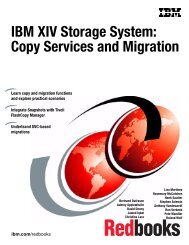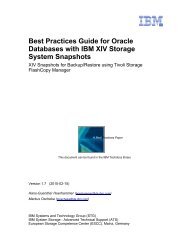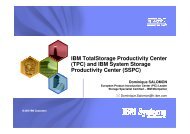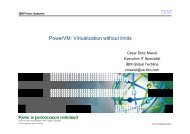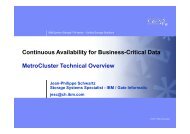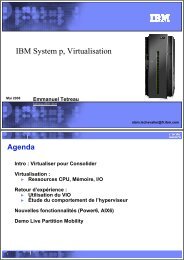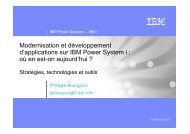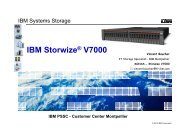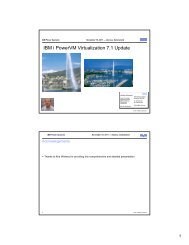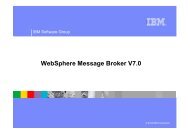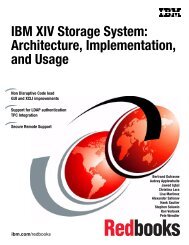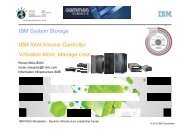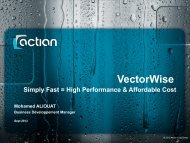Offre IBM Power Systems
Offre IBM Power Systems - Common Romandie
Offre IBM Power Systems - Common Romandie
Create successful ePaper yourself
Turn your PDF publications into a flip-book with our unique Google optimized e-Paper software.
<strong>Offre</strong> <strong>IBM</strong> <strong>Power</strong> <strong>Systems</strong>Philippe Vandamme / Emmanuel Tetreauphilippe_vandamme@fr.ibm.com / tetreau@fr.ibmMars 2008© 2008 <strong>IBM</strong> CorporationAgendaMatériel• Processeurs• Gamme• Serveurs <strong>Power</strong>6• Lames JSxxVirtualisation• Bases• Integrated Virtual Ethernet (IVE)• Live Partition Mobility (LPM)• Virtual Shared PoolsAIX• Partition Mobility•Workload PartitionsHMC V7VIO 1.52 © 2008 <strong>IBM</strong> Corporation
Processor Instruction Retry and RecoveryRécupération Hardware d’erreurs transitoiresRetryAlternate Processor RecoveryLPAR-1LPAR-2LPAR-3LPAR-4CoDConservation d’un état valide (checkpoint)effectuée par le coeurCPUCPUCPUCPU• Capable de préserver l’état de l’opération en coursCPUCPUCPUSi une erreur non corrigeable est détectée• Rejoue de l’opération à partir du dernier point d’arrêt• Elimine les erreurs transitoiresCPUAIX KernelCPU CPUCPU CPUAIX Kernel AIX KernelHypervisorCPUCPUAIX Kernel• Si insuffisant• Rejoue sur un autre coeur• Eventuellement sur processeur en spare (COD) si dispoVirtualCPU CPUDedicated• Isolation de l’anomalie en arrêtant juste le processeuren erreur (checkstop)CPUCPUCPUCPUShared Pool7 © 2008 <strong>IBM</strong> CorporationInterconnexion des processeurs POWER6Implementation en étoileAmélioration de l’interconnexion des coeurs qui permetun câblage point à point entre les noeuds4 socketsBénefices:• Réduction de la latence de la communication entre coeurs• Réduction du nombre de câbles• Plus de changement de flex lors de l’ajout d’un noeud p570SOD Hot Nod Add, Cold Nod RepairpSeriespSeriespSeries32 socketspSeries8 © 2008 <strong>IBM</strong> Corporation
pSeriespSeriesGamme à base de processeurs <strong>Power</strong>6p570p575p595Format19-pouces 4URack /CECProcesseur<strong>Power</strong>6<strong>Power</strong>6<strong>Power</strong>6# de coresFréquence (GHz)De 2 à 163.5, 4.2, 4.732/Nœud – 448/Frame4.78 à 644.2 et 5.0Cache L332Mo / Chip32Mo / Chip32Mo / ChipMémoire (Go)Disques internesSlots PCISlots sur GX BusIVETiroirs I/OMicro-partitions (Max) **Versions d’AIXVersions Linux®Bench tpmcrperfConsommation (MAX)1 à 768 Go1 à 6 par CEC2 PCI-X, 4PCI-e2* par CEC2 ou 4 ports GbpsOu 2 à 10Gbps / CECMax 81605.2TL10, 5.3TL6 sp4, 6.1RH 4.5 & 5,SLES 10404 462 (4Cores)1 616 162 (16 Cores)15.85-134.351428W par CEC32 à 256 Go1 à 2 par nœud4 par nœud2 par nœudN/AMax 5 par frameN/A5.3 TL8RH 4.6 & 5.2SLES 10 SP269.6 kW16Go à 4 TB16 par I/O Drawer20 par I/O Drawer4 par bookN/AMax 302545.3TL6,TL7,TL8 et 6.1TL1RH 4.7 & 5.2SLES 10 SP2(Juillet 2008)75.58 - 55327.7 kW15 * Partagé avec slots PCI ** Nécessite l’option <strong>Power</strong>VM© 2008 <strong>IBM</strong> Corporation<strong>Power</strong> 520 - 4U Rack & TourArchitectureMémoire DDR2HDD Internes SASSlots d’extensionContrôleur SAS / SATAPorts IntégrésIntegrated VirtualEthernetMedia BaysRemote I/O DrawersDynamic LPARAlimentation redondanteVentilation redondante<strong>Power</strong> 520 Rack & Tour1, 2 ou 4 cores @ 4.2 GHzL3 Cache: N/AJusqu’à 64 GB (Buffered )Jusqu’à 6 DASD (3.5”)Optionnel: SFF DASD• PCIe: 3 Slots• PCI-X 266: 2 Slots• GX Bus: 2 Slots dont 1Partagé avec 1 slot PCIeOui3 USB, 2 Serial, 2 HMCOptionnel: port SAS• Dual Port 10/100/1000 Ethernet• Optionnel: Quad 1Gbt or Dual 10Gbt1 Slim-line DVD1 Half High TapeYes / Max: 8GX Bus connexion: RIO2 / InfiniBandJusqu’a 40 partitionsOui - optionnelleOuiOptionnel: RAID support16 © 2008 <strong>IBM</strong> Corporation
<strong>Power</strong> 520: quelques chiffres3530rPerf3530FormeCoresFréquence & ProcCache L2Cache L3MémoireDisquesSlots PCI-xSlots PCI-expressLPARsTiroirs IOBande passante memBande passante IOrPerfp5-520/QTour ou Rack 4U/19pouces1, 2, 4 (Q)1.65 (Q), 1,9, 2.1 GHzPOWER5+1.9 Mo par core36 Mo par paire1 à 32 Go / 8 DIMMs8 / 2.4 To6010 par core421.1 Go/s4.4 (Q) ou 5 Go/s12.46, 20.25p5201, 2, 44.2 GHzPOWER64 Mo par coreN/A1 à 64 Go 8 DIMMs6 / 1.8 To2310 par core832 Go/s14 Go/s8.39 / 15.95 / 31.482520151050403530252015p5-520 p5-520Q p520rPerf/KW252015105014121086Bande PassanteMémoirep5-520Qp520Bande PassanteIO104520p5-520 p5-520Q p5200p5-520Qp52017 © 2008 <strong>IBM</strong> Corporation<strong>Power</strong> 550 Rack & Tour<strong>Power</strong> 550 Rack & TourArchitectureMamoire DDR2HDD Internes SASSlots d’extensionContrôleur SAS / SATAPorts IntégrésIntegrated VirtualEthernetMedia BaysRemote I/O DrawersDynamic LPARAlimentation redondanteVentilation redondante2, 4, 6 or 8 cores @ 3.5 & 4.2 GHzCache L3 : 32 MB par chipJusqu’a 256 GB (Buffered )Jusqu’a 6 DASD (3.5”)Optionnel Jusqu’a 12 SFF DASD• PCIe: 3 Slots• PCI-X 266: 2 Slots• GX Bus: 2 Slots dont 1Partagé avec 1 slot PCIeOui3 USB, 2 Serial, 2 HMCOptionnel: port SAS• Dual Port 10/100/1000 Ethernet• Optionnel: Quad 1Gbt ou Dual 10Gbt1 Slim-line DVD1 Half High TapeOui / Max: 8Connexion GX Bus : RIO2 / InfiniBandJusqu’a 80 partitionsOui – optionnelleOuiOptionnel: RAID18 © 2008 <strong>IBM</strong> Corporation
P550: quelques chiffresFormeCoresFréquence & ProcCache L2Cache L3MémoireDisquesSlots PCI-xSlots PCI-expressLPARsTiroirs IOBande passante memBande passante IOrPerfSpecjbb2005p5-550/Q2-4, 4-8 (Q)1.65 (Q), 1,9 & 2.1 GHzPOWER5+1.9 Mo par paire36 Mo par paire1 à 64 Go / 16 DIMMs8 / 2.4 To5010 par core, max 40842.2 Go/s8.4 Go/s24.86, 38.34Tour ou Rack 4U/19poucesp5502, 4, 6, 83.5 & 4.2 GHzPOWER64 Mo par core32 Mo par paire1 à 256 Go 32 DIMMs6 / 1.8 To2310 par core, max 808128 Go/s14 Go/s15.85 / 31.27 / 45.04 / 58.8018.38 / 36.24 / 52.24 / 68.2333 779 bops -- 83 445 bops/JVM50454080706050403020100rPerf4c 8c 8c 16cp5-550 p5-550Q p550 p560QrPerf/KW351301201430110100122590 Bande Passante10802070 Mémoire86015506 Bande Passante40104IO304c 8c 8c 16c20102500019 p5-550/Qp550p5-550/Qp550© 2008 <strong>IBM</strong> Corporationp5-550 p5-550Q p550 p560Q<strong>IBM</strong> System p570 9117-MMARack 19“4U16 coresLinux5.2 &5.3Assemblage par brique 4U – 19 poucesDe 2 à 16 cores 3.5, 4.2 ou 4.7 GHz12 cores8 cores2/4 coresCores3,5 GHz4,2 GHz4,7 GHzrPerf AIX 5.34 8 1231,69 58,95 83,3536,76 68,38 96,6840,26 74,89 105,8916105,75122,67134,35SAP ECC 6: 8 000 users, 1.98 stpmc 16 cores 4.7 GHz: 1 616 162 / 3.54$tpmc 4 cores 4.7 GHz: 404 462,54 / 3.50$Specjbb2005: 691 975 bops - 89 497 bops/JVM20 © 2008 <strong>IBM</strong> Corporation
<strong>Power</strong> 570ProcesseurCache L3Alimentation et refroidissementredondantSFP RedondantHorloge redondanteAjout d’un nœud à chaudGarrantie3.5 / 4.2 / 4.7 GHz POWER632 MB / ChipOuiOptionnel (au minimum 2 nœuds)Oui (détection à froid, au minimum 2 nœuds)Oui1 an, NBDPar boitier (CEC) Maximum par serveurProcesseur (Core)Mémoire DDR2 (Buffered)Baies HDD SAS (3.5”)Media BaysContrôleur SAS/SATASlots PCI (Internal)Slots GX BusIntegrated Virtual Ethernet(IVE)USBRemote I/O DrawersDynamic LPARs42-19261 Slim-line14 PCIe, 2 PCI-X 2662Dual Port 10/100/1000Quad Port 1 Gb (Optional)Dual Port 10 Gb (Optional)28 Max D11/D20/G304016768244 Slim-line416 PCIe, 8 PCI-X 26684 Dual Port 10/100/10004 Quad Port 1 Gb (Optional)4 Dual Port 10 Gb (Optional)832 Max D11/D20/G3016021 © 2008 <strong>IBM</strong> Corporation<strong>Power</strong> 575<strong>Power</strong> 575 (9125-F2A)ArchitectureCacheMémoire (DDR2)Disques InternesSlots PCIContrôleur SASSlots GXEthernet intégréPOWER32-cores par nœud1 à 14 Nodes / rack ( 448 Cores )4.7 GHzL3: 32MB / Chip32 à 256 Go par nœud2 SAS SFF DASD ( 2.5”)PCIe : jusqu’a 4 SlotsOuiDeux slots GX BusDeux Dual 10/100/1000 EthernetOptionnel: Dual 10Gb Optical1 - 4 Nodes 2 Line Cords5+ Nodes 4 Line Cords5.3RefroidissementRemote IODrawersCombinaison Eau/AirOui Qty: 0, ½ or 1PCI-X ( 20 Slots & 16 DASD )Linux22 © 2008 <strong>IBM</strong> Corporation
POWER 6 Blade JS22 7998-61XArchitectureCache L3Mémoire DDR2DisquesOption carte associéeBaseSupport Fiber ChanelBaie médiaAlimentation redondée4 coeurs en 2 Sockets @4 GHz -- 30.26 rPerf--2 à 32 Go (4 DIMM, Chip Kill ) -- FB-DIMM0 ou 1 disque SAS 73 ou 146 GoLegacy, SFF ou High speed DCEthernet 10/100/1000 cuivre 2 portsContrôleur SAS, Port USBOui via Blade center1 via Blade CenterOui - Blade CenterBladeCenter H & S*Ventilation redondéeProcesseur de serviceVirtualisationSystème d’exploitationSupport NEBSOui - Blade CenterOuiAIX 5L V5.3, AIX 6 & Linux<strong>Power</strong>VM Standard ou Enterprise EditionAIX 5.3, 6.1, RH 4.5 & 5, SLES 10 U1Oui25 © 2008 <strong>IBM</strong> Corporation*nécessite firmware GA1 FP1 fin fevPOWER 6 Blade JS2226 © 2008 <strong>IBM</strong> Corporation
POWER 6 Blade JS12BladeCenter H & S*ArchitectureCache L3Mémoire DDR2DisquesOption carte associéeBaseSupport Fiber ChanelBaie médiaAlimentation redondéeVentilation redondéeProcesseur de serviceVirtualisationSystème d’exploitationSupport NEBS2 coeurs en 1 Socket @3.8 GHz -- 14.7 rPerf--2 à 64 Go (8 DIMM, Chip Kill ) -- FB-DIMM0 à 2 disques SAS 73 ou 146 GoLegacy, SFF ou High speed DCEthernet 10/100/1000 cuivre 2 portsContrôleur SAS, Port USBOui via Blade center1 via Blade CenterOui - Blade CenterOui - Blade CenterOuiAIX 5L V5.3, AIX 6 & Linux<strong>Power</strong>VM Standard ou Enterprise EditionAIX 5.3, 6.1, RH 4.5 & 5, SLES 10 U1Oui27 © 2008 <strong>IBM</strong> Corporation*nécessite firmware GA1 FP1 fin fevPOWER 6 Blade JS1228 © 2008 <strong>IBM</strong> Corporation
BladeCenter SChâssis 19 pouces, 7 U – 28,9 pouces de profondeur• Accueille 6 (30 mm) lames 2 cores ou 3 lames 4 coresSupporte toutes les lames <strong>IBM</strong> <strong>Power</strong>, AMD, Intel …• 12 3.5 disques 3.5 pouces SAS (3.6 To max) ou SATA (6To max)Disques en pool (RAID) ou dédiés• DVD-Rom• Alimentation et ventilation redondante & hot-swap• Module de gestion « Advanced Management Module »• GUI de configuration du stockage• AAS disponible en maiPorts Ethernetbaie I/O 1Connexion des LamesAdapt SAS (DSMs), Eth & FCbaies 3 & 4Futurs adaptateurs pour redondance Ethbaie 229 © 2008 <strong>IBM</strong> CorporationSystem Storage EXP 12S (SAS Disk Drawer)Tiroir IO SAS• 12 disques SAS 73, 146 ou 300 Go 15 000 tr/mn• Dual SAS expanders• Alimentation & Ventilation redondéesEn option• Chainage de 2 EXP 12S sur un seul port IOA• Connexion sur 2 IOAsCharactéristiques• Rack 19" – 2U• H x L x P: 87.7 x 448.6 x 530 mm• 17.7 Kg sans les disquesRésilience• Disques Hot-swap• Expanders SAS redondé et hot-swap• Alimentation & Ventilation redondées et hot-swap• 2 cordons d’alimentation• LED de status sur disques, expander, alim• Chemin de données redondant• Processeur de diagnostic independant pour chaque expander30 © 2008 <strong>IBM</strong> Corporation
Virtualisation31 © 2008 <strong>IBM</strong> CorporationPossibilités de virtualisation3coeursAIX5.34 cœursLinux0,5 coeurVIOServer1StorageEthernetSharingAIX 5L v5.3Virtual Drivers8 cœursMicropartitionsAIX 6.1LinuxAIX 6.1<strong>Power</strong> HypervisorLinuxAIX 5L v5.3LAN, WAN, …0,5 coeurVIOServer2StorageEthernetSharingVirtual IOpathMicro-Partitionnement• Processeurs partagés entre partitions• Mini: 1/10ème de coeur/partition• Incrément 1/100ème de coeur• AIX 5L V5.3 ou Linux kernel 2.6• Integrated Virtual Ethernet (p6)Virtual I/O server• Ethernet Partagé• Réseau inter-partition interne basé sur la mémoire• Disques SCSI et Fibre Channel partagés• Média optiques• Support des partitions AIX 5L v5.3• Support des partitions Linux kernel 2.6Modifiable dynamiquementAccounting• Outils de base et offre complémentairePLMManagerServerPLM partitionsLPARsAIX 5.3PLM AgentLPARsAIX 5.2PLM Agent<strong>Power</strong> HypervisorUnmanagedpartitionsLinuxAIX 6Partition Load Manager• Support d’AIX 5L V5.2 et 5.3• Equilibrage des besoins en ressources mémoire etprocesseur32 © 2008 <strong>IBM</strong> Corporation
Shared Dedicated CapacityPermettre à une partition de libérer ses ressources processeurs non utilisées avec la réactivitéet les performances des processeurs dédiés3 LPARs sur un serveur deux cores:• 2 LPARs non bridées qui se partagent la puissance disponible• 1 LPAR à coeur dédié / Shared Dedicated CapacityNon bridée 1: Non bridée 2:Puissance perdue:1 coeur Dédié 1 coeur Shared Dedicated Capacity2001751501251007550250• Avec un cœur Dédié, les cycles non utilisés par la partition bleu clair sont perdus.• En « Shared Dedicated Capacity » du POWER6, la partition bleu clair va libérer ses cycles processeuren excès au profit des partitions non bridées qui en font la demande.• Les partitions vertes partageront un processeur quand la partition à processeur SDC sera fortement sollicitée etpourront utiliser les 2 coeurs quand la partition bleu claire est inutilisée.La capacité totale des ressources processeur du système est mieux utilisée tandis que la partition àprocesseurs Shared Dedicated Capacity conserve les caractéristiques de performance et de prévisibilitédes environnements dédiés lors des fortes charges.35 © 2008 <strong>IBM</strong> CorporationVirtual Shared Processor Pool6 Processeurs physiques dans le poolVirtual pool 1 Virtual pool 2Virtual pool 3Segmentation : Prod / Test / DevMaîtrise des coûts de licence«Capping» de partitions non bridéesRedimmensionnement dynamiqueAffectation dynamique des LPARs au poolJusqu’à 64 pool virtuelsConditions: <strong>Power</strong>6, HMC (pas IVM), AIX 5.3 TL7 ou AIX 6.1, Linux à terme36 © 2008 <strong>IBM</strong> Corporation
<strong>Power</strong>VM Live Partition MobilityLa migration de partition active permet de déplacer une partition d’une machine physique à une autresans interrompre le fonctionnement du système d’exploitation et sans perturber les applications.HMCVIOSLANSANVIOSLPARBootPagingApplicationLa “Partition Mobility” est supportée sur POWER6en AIX 5.3 TL7, AIX 6.1, RHEL 5.1 et SLES 10sp1Au cours du déplacement, la partition ne doit utiliser que des interfaces virtuelles via les VIO Servers,Les deux serveurs doivent être dans le même subnet sinon les connexions utilisateurs tombent,Les disques virtuels doivent être sur un SAN commun aux VIOs des deux systèmes,Ils doivent être déclarés comme des Physical Volumes (pas de lvm du VIO),Les 2 serveurs doivent être pilotés par la même HMC. Ou entre 2 IVM.Licence: <strong>Power</strong>VM Enterprise Edition37 © 2008 <strong>IBM</strong> CorporationAIX38 © 2008 <strong>IBM</strong> Corporation
Calendrier des sorties AIX 5L V5.32006 2007 2008 2009 2010Printemps Automne Printemps Automne Printemps Automne Printemps Automne PrintempsTechnologyLevel 4SPCSPSPCSPCette Cette nouvelle nouvelle stratégie stratégie commence avec avec AIX AIX5.3 5.3 TL6 TL6 en en Juin Juin 2007*. 2007*.AIX 5L V5.3 TL4 et TL5 continuera à être supporté selon l’ancienne stratégieAIX 5L V5.3 TL4 et TL5 continuera à être supporté selon l’ancienne stratégieAIX 5L V5.2 n’est pas concernéAIX 5L V5.2 n’est pas concernéTechnologyLevel 5SPSP SP SP SPLegend:HP SPSPCSPTechnologyLevel 6Service Pack – may include new HWService Pack – AIX 5L fixes onlyConcluding Service Pack – Last Service PackInterim FixSupport via Interim Fix, PTF, or Service PackSupport via CSP + Interim FixNew Technology Level - New HW/SW supportand hardware exploitation)HP SP HP SP HP SPTechnologyLevel 7SPSP SP SP SPHP SP HP SP HP SPTechnologyLevel 8HP SP HP SP HP SP39 © 2008 <strong>IBM</strong> CorporationSPSP SP SP SPCompatibilité binaire AIX 6Ross A MauriGeneral Manager<strong>IBM</strong> System p40 © 2008 <strong>IBM</strong> Corporation
Matériel supporté en AIX 6AIX 6 supportera les matériels construits à base de:POWER4, PPC970, POWER5 et POWER6Les applicatifs 32- et 64-bit continueront à tourner de manière inchangée en AIX6AIX 6 n’embarque q’un seul noyau : 64-bit*Complete details on AIX binary compatibility can be found at http://www.ibm.com/servers/aix/os/compatibility/41© 2008 <strong>IBM</strong> CorporationAll statements regarding <strong>IBM</strong>'s future direction and intent are subject to change or withdrawal without notice, and represent goals and objectives onlyPOWER6 et AIX 6 : Qui fait quoiApportée parOS supportéMatériel supportéFonctionnalitéFware<strong>Power</strong>VMAIXV6.1AIXV5.3AIXV6.1LinuxPOWER4POWER5POWER6<strong>Power</strong>VM Live PartMobilityMultiple virtual shared poolsStandard, E Ed(HMC)<strong>Power</strong>VM AIX6 WLPARLive Application MobilityEnterprise EdIntegrated Virtual EthernetStorage keys - applicationStorage keys – kernelDedicated processor sharingHardware Decimal FPVMX Altivec (SIMD)42 © 2008 <strong>IBM</strong> Corporation
<strong>Power</strong>VM AIX6 Workload Partitions (WLPAR)Environnements applicatifs séparés au sein d’une même instance AIX 6.1Réduction du nombre d’images systèmes à installer et maintenirDeux types de Workload Partitions• System Workload Partitions• Application Workload PartitionsPartitionnement logiciel• Chaque WLPAR obtient une partie des ressources processeur etmémoire• Chaque WLPAR a ses propres systèmes de fichiers, ses adressesIP ainsi qu’un certains nombre de services (ex telnetd …)Administration séparée• Chaque System Workload Partition est un domained’administration et de sécurité séparé.WorkloadPartitionCWorkloadPartitionAWorkloadPartitionDWorkloadPartitionBWorkloadPartitionEPartage des ressources de la partition hôte• Entrées/Sorties• Processeur / mémoire• Système d’exploitation• Shared Library et TextCréation en quelques minutes• Grande finesse de paramétrageAIX 6.1Kernel43 © 2008 <strong>IBM</strong> CorporationLive Application MobilityAIX Image 1AIX Image 2WorkloadPartitionAWorkloadPartitionCWorkloadPartitionEApplicationPartitionDWorkloadPartitionB<strong>Power</strong>VM AIX6WorkloadPartitionsManagerPolicyWorkloadPartitionRWorkloadPartitionQWorkloadPartitionSConserve l’état de l’application, connexions TCP incluses, pendant le transfert.Le logiciel additionel <strong>Power</strong>VM AIX 6 Workload Partitions Manager automatise les migrations suivant desrègles (policies) pour :• L’optimisation des ressources (consolidation / deconsolidation)• L’optimisation des performances (scale out, scale up)• L’optimisation de la disponibilité (predictive fail over)Déplacement des applications, pas du système; les interfaces sont réelles ou virtuelles !“Live Application Mobility” est supportée sur AIX 6.1en PPC970, <strong>Power</strong>4, <strong>Power</strong>5 et <strong>Power</strong>6Les deux serveurs peuvent avoir des configurations différentes mais sont de même type P4-P4, P5-P5, etc …Les deux serveurs doivent être dans le même subnet sinon les connexions utilisateurs tombent,Les deux instances AIX sont au même niveau de TL et Service Pack,Les applications et leurs données sont accédées via NFS v444 © 2008 <strong>IBM</strong> Corporation
<strong>Power</strong>VM AIX6 Workload Partitions ManagerOutil optionnel de gestion centralisée des Workload PartitionsUne Interface Graphique unique pour:• Création et destruction• Arrêt et redémarrage• Checkpoint & Restart• Monitoring et Reporting• Déplacement manuel• Déplacement automatique• Définition de règles de déplacementWorkloadPartitionManagerBrowserOptimisation de l’infrastructureEquilibrage de chargeGlobal LevelWPAR AgentWeb ServiceGlobal LevelWPAR AgentGlobal LevelWPAR AgentSystem/Application WPARsSystem/Application WPARsSystem/Application WPARs45 © 2008 <strong>IBM</strong> CorporationAIX 6 Concurrent MaintenanceApplication de correctifs kernel sans arrêt de serviceApplication de correctifs sur un noyau AIX 6.1 en service• Base AIX Kernel (/unix), kernel extension ou device driverAucun arrêt pour l’appliquer, ni l’activerLes Concurrent Updates s’appliquent comme des Interim Fixesvmmove()sleepx()getgidx()Kernel SpaceUser SpaceemgrConcurrent updatevmmove() patchInterim Fix46 © 2008 <strong>IBM</strong> Corporation
AIX Storage KeysUNIX AIX Kernel Address SpaceApplicationAddress SpaceAIX KernelAIX DriversThird Party DriversJFS2 LVM VMM . . . SCSI ENT FC . . . PPath Artic VxFS . . .WSDB2KernelUserCodeCodeKernelDataUserDataFilesAvec un Unix standard, une routine privilégiée peut écraser n’importe quelle portion mémoire de sa partition• Provoque des problèmes intermittents, souvent fatals à l’application, difficiles à identifier et corriger.POWER6 Storage Keys isolent les sous-systèmes et les applications et les protègent d’un écrasement externe• Gérées par des fonctions hardware du power6La première version permettra de créer 8 Storage Keys• Sera étendue progressivement pour affiner et améliorer la protection offerteExtensible aux applications pour protéger des zones au sein des applications• AIX fournit des API pour l’utilisation par des applications, exemple DB2.Application keys en AIX V5.3 - Kernel key exploitation en AIX 647 © 2008 <strong>IBM</strong> CorporationRésuméCompatibilité binaireVersions précédentes AIX 5LPOWER4, POWER5, <strong>Power</strong>PCVirtualisationWorkload PartitionLive Application MobilitySécuritéSystème de fichiers crypté, role based access controlDisponibilité en continuMise à jour du kernel AIX dynamique, Clé de protection mémoire…GestionConsole System Director pour AIX48 © 2008 <strong>IBM</strong> Corporation
HMC49 © 2008 <strong>IBM</strong> CorporationHMC– Version 7Web UI – Nouvelle présentation au format WebBarre destâchesNavigationZone detravailBarre de status• Communication chiffrées (SSL – certificat)• Compatibilité Mozilla Firefox 1.5+ pour Windows et Linux, Microsoft IE 6.x +• Accès distant à activer50 © 2008 <strong>IBM</strong> Corporation
HMC– Version 7Nouvelle version mise à disposition : 7.3.2.0• En accord avec le niveau de microcode 01_EM310_010 (p6)Serveurs supportés• La Version 7 est requise pour les serveurs p6• Supporte également tous les serveurs p5 au niveau de firmware supérieur ou égal à SF240Compatibilité• Compatibilité ligne de commande préservée• DHCP identique au POWER5• Nécessaire pour les systèmes 24” (590 / 595 / 575 (p5 et p6)• Mise à jour à partir de la version 6 (seulement)HMC matériel supporté• Anciennes HMC p5 (Machine Type 7310) sont supportées• Nouvelle HMC Machine Type 7042 (HMC <strong>Power</strong>6)• Anciennes HMC p4 (Machine Type 7315) ne sont pas supportéesRègle des 8 mètres supprimée• Il n’est plus nécessaire d’avoir une HMC dans un rayon de 8 mètres autour du serveur. L’inspecteur demaintenance à juste besoin d’avoir un navigateur WEB à sa disposition dans ce rayon.51 © 2008 <strong>IBM</strong> CorporationVIO52 © 2008 <strong>IBM</strong> Corporation
VIO Server version 1.5.1Virtual I/O ServerSupport étendu pour les protocoles standard de l’industrie• Gestion des utilisateurs centralisée au travers de LDAP• Support de la gestion et surveillance via SNMP• Automatisation de l’enregistrement des VLAN sur les « switchs » externesvia GVRPExtension du support de sous-systèmes de stockage– Support de SAS (pour les disques) et SATA (contrôleur disque optique)– Support SAS Split Disques– Support pour les nSeries et NetApp– Attachement iSCSI et fibre channel53 © 2008 <strong>IBM</strong> CorporationVIO Server version 1.5.1Virtual I/O ServerAméliorations de la gestion du système• System Planning and Deployment tool: Simplification de la planificationet du déploiement des configurations System p, Virtual I/O server etContrôleurs virtuels.• CLI: extension des commandes ligne pour l’administration, la sécurité etla gestion des utilisateurs• Sous IVM, déplacement dynamique de ressources, allocation de cartesdédiéesSupport Agents Tivoli– Support de l’agent <strong>IBM</strong> Tivoli Storage Manager pour la sauvegarde etrestauration des partitions VIOs– Support de l’agent <strong>IBM</strong> Tivoli Usage and Accounting Manager pourla récupération et l’analyse des métriques.– Support de l’agent <strong>IBM</strong> Tivoli Application Dependency DiscoveryManager pour la découverte des ressources VIOS et System p.54 © 2008 <strong>IBM</strong> Corporation
Notes on benchmarks and valuesThe <strong>IBM</strong> benchmarks results shown herein were derived using particular, well configured, development-level and generally-available computer systems. Buyers shouldconsult other sources of information to evaluate the performance of systems they are considering buying and should consider conducting application oriented testing. Foradditional information about the benchmarks, values and systems tested, contact your local <strong>IBM</strong> office or <strong>IBM</strong> authorized reseller or access the Web site of the benchmarkconsortium or benchmark vendor.<strong>IBM</strong> benchmark results can be found in the <strong>IBM</strong> <strong>Power</strong> <strong>Systems</strong> Performance Report at http://www.ibm.com/systems/p/hardware/system_perf.html.All performance measurements were made with AIX or AIX 5L operating systems unless otherwise indicated to have used Linux. For new and upgraded systems, AIXVersion 4.3, AIX 5L or AIX 6 were used. All other systems used previous versions of AIX. The SPEC CPU2006, SPEC2000, LINPACK, and Technical Computingbenchmarks were compiled using <strong>IBM</strong>'s high performance C, C++, and FORTRAN compilers for AIX 5L and Linux. For new and upgraded systems, the latest versions ofthese compilers were used: XL C Enterprise Edition V7.0 for AIX, XL C/C++ Enterprise Edition V7.0 for AIX, XL FORTRAN Enterprise Edition V9.1 for AIX, XL C/C++Advanced Edition V7.0 for Linux, and XL FORTRAN Advanced Edition V9.1 for Linux. The SPEC CPU95 (retired in 2000) tests used preprocessors, KAP 3.2 for FORTRANand KAP/C 1.4.2 from Kuck & Associates and VAST-2 v4.01X8 from Pacific-Sierra Research. The preprocessors were purchased separately from these vendors. Othersoftware packages like <strong>IBM</strong> ESSL for AIX, MASS for AIX and Kazushige Goto’s BLAS Library for Linux were also used in some benchmarks.For a definition/explanation of each benchmark and the full list of detailed results, visit the Web site of the benchmark consortium or benchmark vendor.TPChttp://www.tpc.orgSPEChttp://www.spec.orgLINPACKhttp://www.netlib.org/benchmark/performance.pdfPro/Ehttp://www.proe.comGPChttp://www.spec.org/gpcNotesBenchhttp://www.notesbench.orgVolanoMarkhttp://www.volano.comSTREAMhttp://www.cs.virginia.edu/stream/SAPhttp://www.sap.com/benchmark/Oracle Applicationshttp://www.oracle.com/apps_benchmark/PeopleSoft - To get information on PeopleSoft benchmarks, contact PeopleSoft directlySiebelhttp://www.siebel.com/crm/performance_benchmark/index.shtmBaanhttp://www.ssaglobal.comMicrosoft Exchangehttp://www.microsoft.com/exchange/evaluation/performance/default.aspVeritesthttp://www.veritest.com/clients/reportsFluenthttp://www.fluent.com/software/fluent/index.htmTOP500 Supercomputers http://www.top500.org/Ideas Internationalhttp://www.ideasinternational.com/benchmark/bench.htmlStorage Performance Council http://www.storageperformance.org/resultsRevised January 15, 200855 © 2008 <strong>IBM</strong> CorporationNotes on HPC benchmarks and valuesThe <strong>IBM</strong> benchmarks results shown herein were derived using particular, well configured, development-level and generally-available computer systems. Buyers shouldconsult other sources of information to evaluate the performance of systems they are considering buying and should consider conducting application oriented testing. Foradditional information about the benchmarks, values and systems tested, contact your local <strong>IBM</strong> office or <strong>IBM</strong> authorized reseller or access the Web site of the benchmarkconsortium or benchmark vendor.<strong>IBM</strong> benchmark results can be found in the <strong>IBM</strong> <strong>Power</strong> <strong>Systems</strong> Performance Report at http://www.ibm.com/systems/p/hardware/system_perf.html.All performance measurements were made with AIX or AIX 5L operating systems unless otherwise indicated to have used Linux. For new and upgraded systems, AIXVersion 4.3 or AIX 5L were used. All other systems used previous versions of AIX. The SPEC CPU2000, LINPACK, and Technical Computing benchmarks were compiledusing <strong>IBM</strong>'s high performance C, C++, and FORTRAN compilers for AIX 5L and Linux. For new and upgraded systems, the latest versions of these compilers were used: XLC Enterprise Edition V7.0 for AIX, XL C/C++ Enterprise Edition V7.0 for AIX, XL FORTRAN Enterprise Edition V9.1 for AIX, XL C/C++ Advanced Edition V7.0 for Linux, andXL FORTRAN Advanced Edition V9.1 for Linux. The SPEC CPU95 (retired in 2000) tests used preprocessors, KAP 3.2 for FORTRAN and KAP/C 1.4.2 from Kuck &Associates and VAST-2 v4.01X8 from Pacific-Sierra Research. The preprocessors were purchased separately from these vendors. Other software packages like <strong>IBM</strong> ESSLfor AIX, MASS for AIX and Kazushige Goto’s BLAS Library for Linux were also used in some benchmarks.For a definition/explanation of each benchmark and the full list of detailed results, visit the Web site of the benchmark consortium or benchmark vendor.SPEChttp://www.spec.orgLINPACKhttp://www.netlib.org/benchmark/performance.pdfPro/Ehttp://www.proe.comGPChttp://www.spec.org/gpcSTREAMhttp://www.cs.virginia.edu/stream/Veritesthttp://www.veritest.com/clients/reportsFluenthttp://www.fluent.com/software/fluent/index.htmTOP500 Supercomputers http://www.top500.org/AMBERhttp://amber.scripps.edu/FLUENThttp://www.fluent.com/software/fluent/fl5bench/index.htmGAMESShttp://www.msg.chem.iastate.edu/gamessGAUSSIANhttp://www.gaussian.comABAQUShttp://www.abaqus.com/support/sup_tech_notes64.htmlselect Abaqus v6.4 Performance DataANSYShttp://www.ansys.com/services/hardware_support/index.htmselect “Hardware Support Database”, then benchmarks.ECLIPSEhttp://www.sis.slb.com/content/software/simulation/index.asp?seg=geoquest&MM5http://www.mmm.ucar.edu/mm5/MSC.NASTRANhttp://www.mscsoftware.com/support/prod%5Fsupport/nastran/performance/v04_sngl.cfmSTAR-CDwww.cd-adapco.com/products/STAR-CD/performance/320/index/htmlNAMDhttp://www.ks.uiuc.edu/Research/namdHMMERhttp://hmmer.janelia.org/http://powerdev.osuosl.org/project/hmmerAltivecGen2modRevised January 15, 200856 © 2008 <strong>IBM</strong> Corporation
Notes on performance estimatesrPerfrPerf (Relative Performance) is an estimate of commercial processing performance relative to other <strong>IBM</strong> UNIX systems. It isderived from an <strong>IBM</strong> analytical model which uses characteristics from <strong>IBM</strong> internal workloads, TPC and SPEC benchmarks.The rPerf model is not intended to represent any specific public benchmark results and should not be reasonably used in that way.The model simulates some of the system operations such as CPU, cache and memory. However, the model does not simulate diskor network I/O operations.rPerf estimates are calculated based on systems with the latest levels of AIX and other pertinent software at the time of systemannouncement. Actual performance will vary based on application and configuration specifics. The <strong>IBM</strong> eServer pSeries 640 isthe baseline reference system and has a value of 1.0. Although rPerf may be used to approximate relative <strong>IBM</strong> UNIXcommercial processing performance, actual system performance may vary and is dependent upon many factors including systemhardware configuration and software design and configuration. Note that the rPerf methodology used for the POWER6 systems isidentical to that used for the POWER5 systems. Variations in incremental system performance may be observed in commercialworkloads due to changes in the underlying system architecture.All performance estimates are provided "AS IS" and no warranties or guarantees are expressed or implied by <strong>IBM</strong>. Buyers shouldconsult other sources of information, including system benchmarks, and application sizing guides to evaluate the performance ofa system they are considering buying. For additional information about rPerf, contact your local <strong>IBM</strong> office or <strong>IBM</strong> authorizedreseller.Revised October 9, 200757 © 2008 <strong>IBM</strong> Corporation



